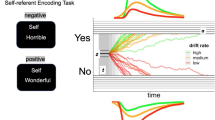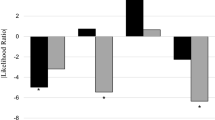Abstract
Cognitive theories assume a uniform processing bias across different samples, but the empirical support for this claim is rather weak and inconsistent. Therefore, coherence between biases across different cognitive domains in a sample of 133 non-depressed (Study 1) and a sample of 266 formerly depressed individuals (Study 2) was examined. In both studies, individuals were selected after a successful sad mood induction procedure. A Dot Probe task, an Emotional Stroop task and a self-referential Incidental Learning and Free Recall task were administered to all participants. Principle component analyses indicated coherence between attentional and memory bias in non-depressed, while in formerly depressed individuals distinct components for attentional biases and for memory bias were uncovered. The data suggest that in formerly depressed individuals, self-referent processing during encoding may be related to memory bias, whereas in non-depressed individuals memory bias may be related to both attentional bias and self-referent processing.
Similar content being viewed by others
References
American Psychiatric Association. (2000). Diagnostic and statistical manual of mental disorders (4th ed., text revision). Washington. DC: American Psychiatric Association.
Beard, C., Sawyer, A. T., & Hofmann, S. G. (2012). Efficacy of attention bias modification using threat and appetitive stimuli: A meta-analytic review. Behavior Therapy, 43, 724–740.
Beck, A. T. (1976). Cognitive therapy and the emotional disorders. New York: International Universities Press.
Beck, A. T. (1983). Cognitive therapy of depression: New perspectives. In P. J. Clayton & J. E. Barrett (Eds.), Treatment of depression: Old controversies and new approaches (pp. 315–350). New York: Raven Press.
Beck, A. T. (2008). The evolution of the cognitive model of depression and its neurobiological correlates. American Journal of Psychiatry, 165, 969–977.
Beck, A. T., Steer, R. A., & Brown, G. K. (1996). Beck depression inventory manual (2nd ed.). Sabn Antonio, TX: Psychological Corporation.
Beevers, C. G., & Carver, C. S. (2003). Attentional bias and mood persistence as prospective predictors of dysphoria. Cognitive Therapy and Research, 27, 619–637.
Bower, G. H. (1981). Mood and memory. American Psychologist, 36, 129–148.
Bradley, M. M., & Lang, P. J. (1999). Affective norms for English words (ANEW): Instruction manual and affective ratings. Technical Report C-1, The Center for Research in Psychophysiology, University of Florida.
Bradley, B. P., Mogg, K., & Lee, S. C. (1997). Attentional biases for negative information in induced and naturally occurring dysphoria. Behaviour Research and Therapy, 35, 911–927.
Eide, P., Kemp, A., Silberstein, R. B., & Nathan, P. J. (2002). Test–retest reliability of the emotional Stroop task: Examining the paradox of measurement change. The Journal of Psychology, 136, 514–520.
Ellis, A. J., Beevers, C. G., & Wells, T. T. (2011). Attention allocation and incidental recognition of emotional information in dysphoria. Cognitive Therapy and Research, 35, 425–433.
Everaert, J., Koster, E. H. W., & Derakshan, N. (2012). The combined cognitive bias hypothesis in depression. Clinical Psychology Review, 32, 413–424.
Fabrigar, L. R., Wegener, D. T., MacCallum, R. C., & Strahan, E. J. (1999). Evaluating the use of exploratory factor analysis in psychological research. Psychological Methods, 4, 272–299.
First, M. B., Spitzer, R. L., Gibbon, M., & Williams, J. B. W. (1995). Structured clinical interview for DSM-IV axis I disorders—patient version 2.0 (SCID-1/P). New York: Biometrics Research Dept, New York State Psychiatric Institute.
Fitzgerald, D. A., Arnold, J. F., Becker, E. S., Speckens, A. E., Rinck, M., Rijpkema, M., et al. (2011). How mood challenges emotional memory formation: An fMRI investigation. Neuroimage, 56, 1783–1790.
Gotlib, I. H., & Joormann, J. (2010). Cognition and depression: Current status and fututre directions. Annual Review of Clinical Psychology, 6, 285–312.
Gotlib, I. H., Kasch, K. L., Traill, S., Joormann, J., Arnow, B. A., & Johnson, S. L. (2004). Coherence and specificity of information-processing biases in depression and social phobia. Journal of Abnormal Psychology, 113, 386–398.
Hallion, L. S., & Ruscio, A. M. (2011). A meta-analysis of the effect of cognitive bias modification on anxiety and depression. Psychological Bulletin, 137, 940–958.
Hertel, P. T., & Mathews, A. (2011). Cognitive bias modification: Past perspectives, current findings, and future applications. Perspectives on Psychological Science, 6, 521–536.
Hirsch, C. R., Clark, D. M., & Mathews, A. (2006). Imagery and interpretations in social phobia: Support for the combined cognitive biases hypothesis. Behavior Therapy, 37, 223–236.
Joormann, J., Dkane, M., & Gotlib, I. H. (2006). Adaptive and maladaptive domponents of rumination? Diagnostic specificity and relation to depressive biases. Behavior Therapy, 37, 269–280.
Joormann, J., & Gotlib, I. H. (2007). Selective attention to emotional faces following recovery from depression. Journal of Abnormal Psychology, 116, 80–85.
Koster, E. H. W., De Raedt, R., Leyman, L., & De Lissnyder, E. (2010). Mood-congruent attention and memory bias in dysphoria: Exploring the coherence among information-processing biases. Behaviour Research and Therapy, 48, 219–225.
Lundqvist, D., Flykt, A., & Öhman, A. (1998). The Karolinska directed emotional faces. Stockholm: Karolinska Institute, Psychology section, Department of Clinical Neuroscience.
Mathews, A., & MacLeod, C. (1994). Cognitive approached to emotiona and emotional disorders. Annual Review Psychology, 45, 25–50.
Mathews, A., & MacLeod, C. (2002). Induced processing biases have causal effects on anxiety. Cognition and Emotion, 16, 331–354.
Mathews, A., & MacLeod, C. (2005). Cognitive vulnerability to emotional disorders. Annual Review Clinical Psychology, 1, 167–195.
Matt, G. E., Vazquez, C., & Campbell, W. K. (1992). Mood-congruent recall of affectively toned stimuli: A meta-analytic review. Clinical Psychology Review, 12, 227–255.
McCabe, S. B., Gotlib, A. H., & Martin, R. A. (2000). Cognitive vulnerability for depression: Deployment of attention as a function of history of depression and current mood state. Cognitive Therapy and Research, 24, 427–444.
Parrott, W., & Sabini, J. (1990). Mood and memory under natural conditions: Evidence for mood-incongruent recall. Journal of Personality and Social Psychology, 59, 321–336.
Peckham, A. D., McHugh, R. K., & Otto, M. W. (2010). A meta-analyses of the magnitude of biased attentional in depression. Depression and Anxiety, 27, 1135–1142.
Phaf, R. H., van der Leij, A. R., Stienen, B. M. C., & Bierman, D. (2006). Positieve, neutrale en negatieve woorden bij minimale aanbieding: Een ordening door perceptuele clarificatie [Positive, neutral and negative words at minimal presentation levels: Ordering by perceptual clarification]. Amsterdam, The Netherlands: Technical Report, Universiteit van Amsterdam.
Raes, F., Williams, J. M. G., & Hermans, D. (2009). Reducing cognitive vulnerability to depression: A preliminary investigation of MEmory Specificity Training (MEST) in inpatients with depressive symptomatology. Journal of Behavior Therapy and Experimental Psychiatry, 40, 24–38.
Raven, J. C. (1958). Standard progressive matrices. London: H. K. Lewis.
Ridout, N., Noreen, A., & Johal, J. (2009). Memory for emotional faces in naturally occurring dysphoria and induced sadness. Behaviour Research and Therapy, 47, 851–860.
Rogers, T., Kuiper, N., & Kirker, W. (1977). Self-reference and the encoding of personal information. Journal of Personality and Social Psychology, 35, 677–688.
Salo, R., Henik, A., & Robertson, L. C. (2001). Interpreting Stroop interference: An analysis of differences between task versions. Neuropsychology, 15, 462–471.
Scher, C. D., Ingram, R. E., & Segal, Z. V. (2005). Cognitive reactivity and vulnerability: Empirical evaluation of construct activation and cognitive diatheses in unipolar depression. Clinical Psychology Review, 25, 487–510.
Schmukle, S. C. (2005). Unreliability of the dot probe task. European Journal of Personality, 19, 595–605.
Segal, Z. V., & Ingram, R. E. (1994). Mood priming and construct activation in tests of cognitive vulnerability to unipolar depression. Clinical Psychology Review, 14, 663–695.
Skre, I., Onstad, S., Torgersen, S., & Kringlen, E. (1991). High interrater reliability for the structured clinical interview for DSM–III–R axis I (SCID-I). Acta Psychiatrica Scandinavica, 84, 167–173.
Vrijsen, J. N., van Oostrom, I., Speckens, A., Becker, E. S., & Rinck, M. (2013). Approach and avoidance of emotional faces in happy and sad mood. Cognitive Therapy and Research, 37, 1–6.
Wells, T. T., Beevers, C. G., Robinson, A. E., & Ellis, A. J. (2010). Gaze behavior predicts memory bias for angry facial expressions in stable dysphoria. Emotion, 10, 894–902.
Williams, J. B., Gibbon, M., First, M. B., Spitzer, R. L., Davis, M., Borus, J., et al. (1992). The structured clinical interview for DSM–III–R (SCID): Multisite test–retest reliability. Archives of General Psychiatry, 49, 630–636.
Acknowledgments
We would like to thank the participants for their time and effort and the Behavioural Science Institute for its support.
Author information
Authors and Affiliations
Corresponding author
Rights and permissions
About this article
Cite this article
Vrijsen, J.N., van Oostrom, I., Isaac, L. et al. Coherence Between Attentional and Memory Biases in Sad and Formerly Depressed Individuals. Cogn Ther Res 38, 334–342 (2014). https://doi.org/10.1007/s10608-013-9590-8
Published:
Issue Date:
DOI: https://doi.org/10.1007/s10608-013-9590-8




